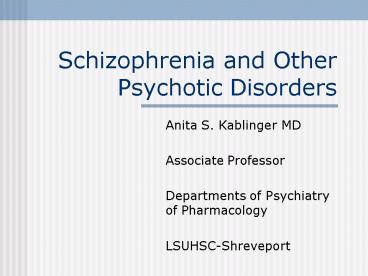Schizophrenia and Other Psychotic Disorders - PowerPoint PPT Presentation
1 / 32
Title:
Schizophrenia and Other Psychotic Disorders
Description:
Caused by a variety of conditions that affect the functioning of the brain. ... Belief in UFO's, etc. Workup of New-Onset Psychosis: 'Round up the usual suspects' ... – PowerPoint PPT presentation
Number of Views:151
Avg rating:3.0/5.0
Title: Schizophrenia and Other Psychotic Disorders
1
Schizophrenia and Other Psychotic Disorders
- Anita S. Kablinger MD
- Associate Professor
- Departments of Psychiatry of Pharmacology
- LSUHSC-Shreveport
2
What is Psychosis?
- Generic term
- Break with Reality
- Symptom, not an illness
- Caused by a variety of conditions that affect the
functioning of the brain. - Includes hallucinations, delusions and thought
disorder
3
Differential Diagnosis
- Medical/surgical/ substance-induced
- Psychotic d/o due to GMC
- Dementias
- Delirium
- Medications
- Substance induced
- Amphetamines
- Cocaine
- Withdrawal states
- Hallucinogens
- Alcohol
- Mood disorders
- Bipolar disorder
- Major depression with psychotic features
4
PSYCHOSIS
Mood disorders
Substance induced
organic mental disorders
Functional disorders
Delirium Dementia Amnestic d/o
Schizophrenia spectrum disorders
5
Differential Diagnoses (Cont)
- Personality disorders
- Schizoid
- Schizotypal
- Paranoid
- Borderline
- Antisocial
- Miscellaneous
- PTSD
- Dissociative disorders
- Malingering
- Culturally specific phenomena
- Religious experiences
- Meditative states
- Belief in UFOs, etc
6
Workup of New-Onset PsychosisRound up the
usual suspects
- Good clinical history
- Physical exam, ROS
- Labs/Diagnostic tests
Metabolic panel CBC with diff B12, Folate RPR,
VDRL Serum Alcohol Urinalysis Thyroid profile
URINE DRUG SCREEN!!!
CSF/LP HIV serology
CT or MRI EEG
7
Talking Points
- Schizophrenia is not an excess of dopamine.
- The differentiation between functional and
organic is artificial. - Schizophrenia and other psychiatric illnesses are
syndromes. - Schizophrenia is a diagnosis of exclusion.
8
Talking Points
- 1 prevalence
- Early onset, MF
- Early, aggressive treatment decreases long-term
problems - Multiple subtypes- catatonic, disorganized,
paranoid, undifferentiated, residual
9
Schizophrenia
- Diagnostic features
10
DSM-IV Diagnosis of Schizophrenia
- Psychotic symptoms (2 or more) for at least one
month - Hallucinations
- Delusions
- Disorganized speech
- Disorganized or catatonic behavior
- Negative symptoms
11
Diagnosis (cont.)
- Impairment in social or occupational functioning
- Duration of illness at least 6 mo.
- Symptoms not due to mood disorder or
schizoaffective disorder - Symptoms not due to medical, neurological, or
substance-induced disorder
12
Clinical featuresFormal Thought Disorders
- Neologisms
- Tangentiality
- Derailment
- Loosening of associations (word salad)
- Private word usage
- Perseveration
- Nonsequitors
13
Clinical featuresDelusions
- Paranoid/persecutory
- Ideas of reference
- External locus of control
- Thought broadcasting
- Thought insertion, withdrawal
- Jealousy
- Guilt
- Grandiosity
- Religious delusions
- Somatic delusions
14
Clinical featuresHallucinations
- Auditory
- Visual
- Olfactory
- Somatic/tactile
- Gustatory
15
Clinical featuresBehavior
- Bizarre dress, appearance
- Catatonia
- Poor impulse control
- Anger, agitation
- Stereotypies
16
Clinical featuresMood and Affect
- Inappropriate affect
- Blunting of affect/mood
- Flat affect
- Isolation or dissociation of affect
- Incongruent affect
17
Positive vs. negative symptoms
- Positive symptoms
- Delusions
- Hallucinations
- Behavioral dyscontrol
- Thought disorder
- Negative symptoms
- (Remember Andreasens As)
- Affective flattening
- Alogia
- Avolition
- Anhedonia
- Attentional impairment
18
Psychotic Disorders
Onset
Symptoms
Course
Duration
19
Psychosocial Factors
- Expressed emotion
- Stressful life events
- Low socioeconomic class
- Limited social network
20
Some factors rejected as causal
- Schizophrenogenic Mother
- Skewed family structure
21
Genetic factors(The evidence mounts)
- Monozygotic twins (31-78) vs dizygotic twins
- 4-9 risk in first degree relatives of
schizophrenics - Adoption studies
- Linkage, molecular studies
22
Genetics of SchizophreniaThe take-home message
- Vulnerability to schizophrenia is likely
inherited - Heritability is probably 60-90
- Schizophrenia probably involves dysfunction of
many genes
23
Anatomical abnormalities
- Enlargement of lateral ventricles
- Smaller than normal total brain volume
- Cortical atrophy
- Widening of third ventricle
- Smaller hippocampus
24
Physiologic studiesPET and SPECT
- Generally normal global cerebral flow
- Hypofrontality
- Failure to activate dorsolateral prefrontal
cortex (problem-solving, adaptation, coping with
changes)
25
Biochemical factorsThe dopamine hypothesis
- All typical antipsychotics block D2 with varying
affinities - Dopamine agonists can precipitate a psychosis
- Amphetamines
- Cocaine
- L-dopa
26
Dopamine systems
Clinical implications
Functions
Cell bodies
Projections
27
Typical Neuroleptics
- Low potency
- Chlorpromazine
- Thioridazine
- Mesoridazine
- High potency
- Haloperidol
- Fluphenazine
- Thiothixene
- Loxapine (mid)
28
Neuroleptic (typicals)side effects
- Acute dystonia
- Parkinsonian side effects (EPS)
- Akathisia
- Tardive dyskinesia
- Sedation, orthostasis, QTC prolongation,
anticholinergic, lower seizure threshold,
increased prolactin
29
Atypical Antipsychotics
- Risperidone
- Olanzapine
- Quetiapine
- Clozapine
- Ziprasidone
- Aripiprazole (new-partial DA agonist)
30
Atypical antipsychotics
- Broader spectrum of receptor activity (Serotonin,
dopamine, GABA) - May be better at alleviating negative symptoms
and cognitive dysfunction - Clozaril (clozapine) associated with
agranulocytosis, seizures
31
Atypical Antipsychotics Side Effects
- Sedation
- Hyperglycemia, new-onset diabetes
- Anticholinergic effects
- Less prolactin elevation
- QTC prolongation
- Some EPS
- Increased lipids
32
Psychosocial Treatment
- Education, compliance 1
- Hospitalize for acute loss of functioning
- Outpatient treatment is rehabilitative
- Psychoanalysis, exploratory therapies have
limited value - Families should be involved

